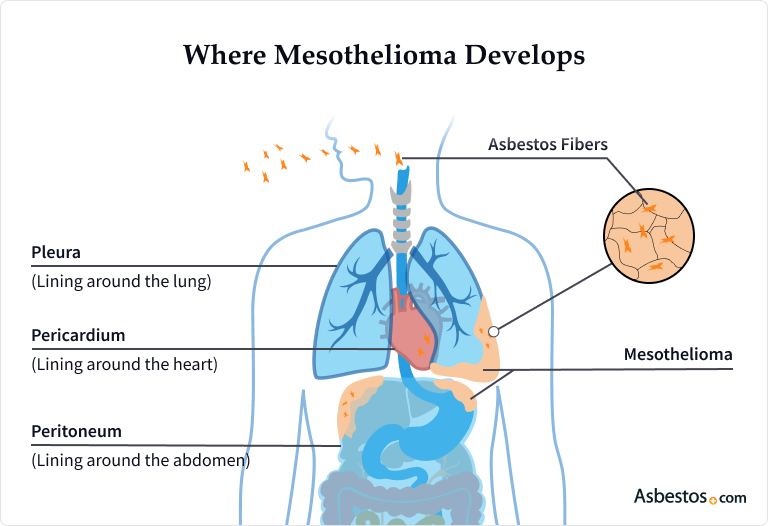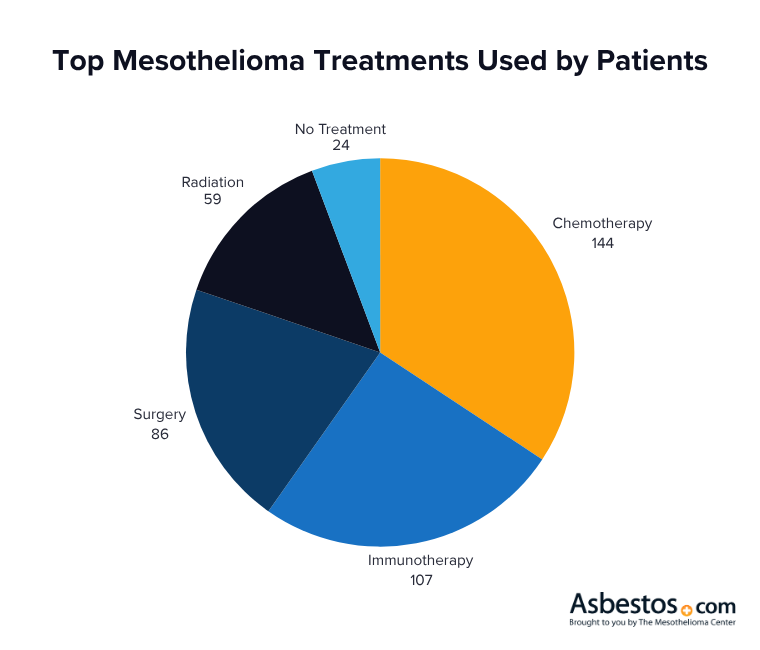Mesothelioma
Mesothelioma is a rare, aggressive cancer that develops in the lining of your body’s organs. Asbestos exposure causes mesothelioma. Most patients are diagnosed decades after asbestos exposure, often unknowingly. Whether you're newly diagnosed, supporting a loved one, or seeking answers, you're not alone. We're here to guide you.
What Is Mesothelioma?
Mesothelioma is a cancer that forms tumors in the mesothelium, a thin membrane lining the lungs, heart, belly and testes. The four types of mesothelioma form on different organs.
The most commonly affected areas are the lining of the lungs and chest wall. But mesothelioma can also affect the linings of the abdomen, heart and testes. Treatment options, outlook and life expectancy can vary among these different mesothelioma types.
Key Points About Mesothelioma
- Main cause: Asbestos exposure is the primary cause of mesothelioma.
- Number of people affected: About 3,000 people in the U.S. are diagnosed with mesothelioma each year.
- Latency period: Mesothelioma can take 20-60 years to develop.
- Treatments: Surgery, radiation therapy, chemotherapy and immunotherapy are the main treatments.
Asbestos is a toxic mineral once commonly used in construction, shipbuilding and military work. Exposure to asbestos is linked to most mesothelioma cases. It often harmed people who never knew they were at risk. Pleural mesothelioma survivor Carla Fasolo told us about her unknowing exposure to asbestos at her father’s job. “I would go down there with [my father], and it was very dusty in the boiler room. There would be chunks of gray, fibrous stuff down there. I didn’t know what it was, but I’d pick it up and play with it.”
Early diagnosis of mesothelioma is crucial for getting the right treatment and improving your quality of life. While there is no cure, there is hope as new treatments like surgery, chemotherapy and immunotherapy can help you manage the disease and feel better.

Types of Mesothelioma Cancer
There are four types of mesothelioma. Mesothelioma may form in the lining of the lungs (pleura), abdomen (peritoneum), heart (pericardium) and testes (tunica vaginalis).
- Pleural mesothelioma: The most common type of mesothelioma, accounting for 70% to 79% of all cases. Pleural mesothelioma forms in the pleura, the protective lining around the outside of the lungs. Doctors recommend immunotherapy, surgery and chemo as treatments.
- Peritoneal mesothelioma: Peritoneal mesothelioma is the second most common type. It forms in the abdominal lining, known as the peritoneum. It has a much higher survival rate. Surgery often works better for this type.
- Pericardial mesothelioma: It affects about 1% of patients. Treatment options are much more limited. The median survival is 2 to 6 months.
- Testicular mesothelioma: The rarest type is testicular mesothelioma. Treatment options are much more limited. About one-third of patients live for at least 10 years.
Sometimes, people with one type of mesothelioma may get another type as the tumors spread.
Mesothelioma Patient and Caregiver Stories
Symptoms of Mesothelioma
The most common symptoms of mesothelioma include fatigue, weight loss and fever. Symptoms of mesothelioma vary based on where the cancer forms in your body.
It usually takes 20 to 60 years after your first exposure to asbestos for symptoms to appear. Experts call this the mesothelioma latency period.
| Symptom | Pleural | Peritoneal | Pericardial | Testicular |
|---|---|---|---|---|
| Abdominal pain or swelling | X | |||
| Chest pain or painful breathing | X | X | X | |
| Difficulty breathing | X | X | X | |
| Fatigue | X | X | X | X |
| Fever or night sweats | X | X | ||
| Irregular heartbeat or palpitations | X | |||
| Swelling or lumps in the testes | X | |||
| Unexplained weight loss | X | X | X |
These symptoms can be unclear and look like other, less serious issues. If you have mesothelioma symptoms, see a specialist for help. Early diagnosis can improve your outlook and help you live longer.

Understand your diagnosis, top doctors and ways to afford care.
Get Your Free GuideWhat Causes Mesothelioma?
Asbestos exposure causes mesothelioma. People can breathe in asbestos fibers from damaged products. Dr. Marcelo DaSilva, chief of thoracic surgery at AdventHealth Cancer Institute, says these inhaled fibers lead to inflammation.
“[Asbestos] causes chronic inflammation in the mesothelium,” Dr. DaSilva tells us. “This can lead to genetic changes.” DNA changes in the cells can cause them to become mesothelioma cancer cells.
Who Is Most at Risk of Mesothelioma?
People who are regularly exposed to asbestos in the workplace and the military are most at risk for mesothelioma. But no amount of asbestos exposure is considered safe.
Other factors may increase the risk that someone exposed to asbestos may develop mesothelioma. These factors include family history, gender, age and overall health.
Mesothelioma Risk Assessment Checklist
If you’ve been exposed to asbestos and are experiencing symptoms like chest or abdominal pain, shortness of breath or fatigue, you may be at higher risk for mesothelioma. This checklist can help you understand your risk level.
- ✔ Occupational exposure in construction, shipyards, schools or industrial work before 1990
- ✔ Worked as a firefighter, auto mechanic or in demolition or home renovation
- ✔ Served in the military where asbestos was used in Navy ships, vehicles or buildings
- ✔ Lived with someone who worked with or around asbestos
- ✔ Lived near asbestos mines, factories or heavy industrial sites
- ✔ Were a heavy user of talcum powder, such as Johnson’s Baby Powder
Next Step: If one or more of these factors applies to you, you may be at risk of mesothelioma. Talk to a Patient Advocate to learn more.
If any of these risk factors apply to you or a loved one, talk to your doctor about mesothelioma screenings. X-rays and other tests can help catch mesothelioma early. Tell your doctor about your exposure and ask how frequently you should be screened.
Diagnosing and Staging Mesothelioma
Doctors diagnose mesothelioma using a combination of tests, such as a physical exam and biopsy. It’s a difficult cancer to diagnose because the symptoms can be a lot like other, more common illnesses.
A diagnosis confirms details such as your cancer type and stage or how far your cancer has progressed. These details help your doctor create the best treatment plan for you.
Methods to Diagnose Mesothelioma
- Physical examination: Doctors usually start by checking for lumps or other unusual signs. They then use lung function tests to check lung health.
- Imaging tests: X-rays, CT scans, MRIs and PET scans help doctors see possible abnormalities in the body.
- Blood tests: Doctors check for specific proteins or biomarkers in the blood. These can help indicate cancer may be mesothelioma.
- Biopsy: This is the definitive way doctors diagnose mesothelioma. Pathologists take a small sample of tissue and examine it under a microscope for cancer cells.
Pathologists also check to see what mesothelioma cell types are present. They may be epithelioid, sarcomatoid or biphasic. Each cell type can respond differently to therapies. Knowing your cell type helps your doctor pick the best treatment plan for you. It also helps them assess your outlook or prognosis.
In 2025, the American Society of Clinical Oncology recommended genetic testing for mesothelioma. It can show mutations that impact treatment. For example, patients with a BAP1 mutation live longer with chemotherapy.
I would tell anyone diagnosed, or their family, to look beyond where they normally would for treatment. There are experts out there who can treat this disease, but you have to find them. You can’t just accept what the first doctor tells you.
Staging Mesothelioma
The stages of mesothelioma describe how far your cancer has progressed, specifically tumor size, distance from the point of origin and location. As tumors grow and spread to distant organs, the stages advance. Stages 1 and 2 are early stages. And stages 3 and 4 are late stages.
| % Patients Diagnosed | % of Male | % of Female | |
|---|---|---|---|
| Stage I | 18% | 18% | 24% |
| Stage II | 11% | 11% | 12% |
| Stage III | 23% | 23% | 20% |
| Stage IV | 48% | 48% | 44% |
Only pleural mesothelioma has a formal staging system. Doctors use the TNM system, which stands for Tumor, Node and Metastasis. The stage of your cancer can affect the treatment options your doctor will recommend for you.

Join our upcoming webinar where two leading mesothelioma specialists explain how they tailor treatment plans to each patient’s needs.
Sign up nowHow Is Mesothelioma Treated?
Doctors treat mesothelioma using surgery, chemo, radiation and immunotherapy. The American Society of Clinical Oncology recommends treatment guidelines and updates them every year.
Your treatment options may vary depending on your mesothelioma type, including whether it’s cancerous or noncancerous. Your overall health will also play a role in determining the best therapies for you.
Types of Mesothelioma Treatments
- Chemotherapy
- Clinical trials
- Immunotherapy
- Multimodal therapy
- Palliative care
- Radiation therapy
- Surgery
- Tumor Treating Fields
Many patients switch to another treatment if one doesn’t show results. Pleural mesothelioma survivor Wally Rogers tells us chemo wasn’t working for him. He swapped chemo for immunotherapy and saw a remarkable recovery.
Wally’s CT scans showed no remaining tumor cells after immunotherapy. His health has improved a lot. Now he says he can hike and ski again. Wally recommends looking into every option to improve your outlook or prognosis.

Mesothelioma Prognosis
The outlook or prognosis for mesothelioma is generally poor, but it improves with treatment. Mesothelioma statistics show 12% of pleural patients live 5 years. The 5-year survival rate for people with the peritoneal type is 65%.
The average life expectancy for mesothelioma is about 12 months. However, your stage at diagnosis, treatments and overall health can impact your prognosis. Treatment and a healthy lifestyle may lead to partial remission. Vaccines can help prevent serious lung infections. Talk to your doctor about ways to boost your prognosis.
As part of my treatment, I had surgery with HIPEC. Studies show HIPEC drastically improves life expectancy in about 50% of the peritoneal mesothelioma patients who have the procedure. It definitely worked in my favor and was a success!
Mesothelioma Prevention and Risk Reduction
You can reduce your risk of mesothelioma by limiting your exposure to asbestos. This includes taking steps at home and at work to avoid contact with asbestos fibers. If you suspect asbestos is in your home, never try to remove it yourself. Instead, hire a licensed professional who is trained in safe asbestos removal.
Occupational exposure to asbestos is the No.1 risk factor for mesothelioma. Workplaces that handle asbestos must follow strict federal, state and local safety regulations to prevent worker injury.
How to Reduce Your Risk of Mesothelioma
- Hire licensed asbestos professionals to handle any suspected materials
- Wear protective gear such as respirators, gloves, and coveralls when near asbestos
- Report unsafe conditions or missing protective equipment to a supervisor or union representative
- Tell your doctor if you’ve been exposed to asbestos so they can monitor your health
- Quit smoking to reduce your risk of lung cancer if you’ve had asbestos exposure
- Avoid secondhand exposure by removing work clothes before going home and showering right after
Protecting yourself and others requires awareness and action. Speaking up and following safety guidelines can help reduce the risk of mesothelioma for you and those around you.
Living With Mesothelioma
Living with a rare cancer, such as mesothelioma, can be tough for patients and their caregivers. It’s normal to worry and feel stressed about how to move ahead.
Your Recommended Next Steps
- Explore clinical trials. They might improve your prognosis.
- Adopt a healthier lifestyle. Simple exercises and a balanced diet can ease your side effects. They can boost your mood while you undergo cancer treatment.
- Join a support group. It can help reduce anxiety, distress, fatigue and pain.
- Financial help covers medical costs. Asbestos trust funds also provide compensation.
- Veterans can access the VA for care and benefits. The VA also offers caregiver benefits and more.
Focus on getting excellent treatment. You can empower your family with knowledge, resources and hope. Peritoneal survivor Tamron Little tells us more resources would have helped her when she was first diagnosed.
“I would have looked for different mesothelioma resources, aid or even support groups,” Tamron shares with us. “That would have helped me while I was battling the disease.”
Commonly Asked Questions About Mesothelioma
- Can mesothelioma go into remission?
-
Yes, some mesothelioma patients experience remission. Remission may be partial or complete.
- How do you know if you have mesothelioma?
-
If you have a history of asbestos exposure, share this with your doctor. Let your doctor know if you have any ongoing symptoms. These include chest pain, a cough or trouble breathing.
- How is mesothelioma different from lung cancer?
-
Mesothelioma isn’t a form of lung cancer. But both diseases are cancers. Mesothelioma grows on the mesothelium, which lines the cavities of the body. It most commonly develops on the part of the mesothelium called the pleura, which is the lining that covers the lungs and chest cavity. Lung cancer develops within the lung tissue.
- Is there a cure for mesothelioma?
-
Mesothelioma isn’t curable. But some patients are living years beyond their life expectancies. Newer treatments like immunotherapy are extending survival. Researchers continue to investigate new treatments through clinical trials.








